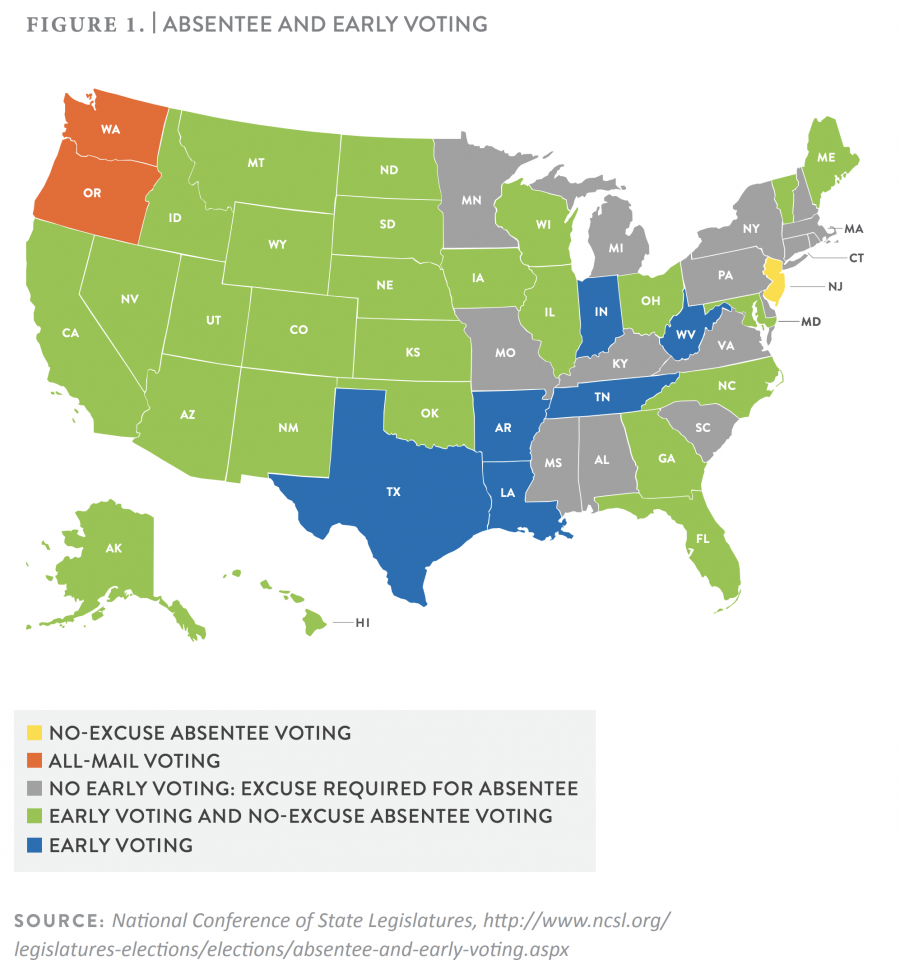Early Voting Comes in Two Basic Forms
Early In-Person Voting
Voters can cast a ballot by appearing in person at a local elections office or other designated location during a designated period prior to Election Day.
Absentee Voting
Voters submit their ballots via mail or by dropping them off at designated locations. Voters simply apply for and receive an absentee ballot in the days or weeks before Election Day. Ideally, absentee ballots are available to any eligible voter, without requiring a narrowly defined reason or “excuse” to obtain and vote an absentee ballot.
Early Voting Is a Cost-Effective Method
For shortening wait times for voting and reducing burdens on polling place officials. It is popular among both voters and election administrators as a means to protect the freedom to vote. Some form of early voting already exists in two- thirds of states.
The Benefits of Early Voting
Reduces Wait Times on Election Day
Wait times in excess of one hour were not uncommon on Election Day in 2012, and some voters reported waiting in lines for up to four hours. By spreading voting over a longer time period, early voting can help relieve the burden of long lines and wait times on Election Day.
Reduces Burden on Election Day Poll Workers
Early in-person and no-excuse absentee voting can provide significant relief to poll workers at crowded polling centers on Election Day.
Early Voting Has the Potential to Increase Turnout and Expand the Electorate.
Academics continue to study the impact of early voting on turnout. Nevertheless, usage of early voting has recently surged among traditionally underrepresented voters. The 2008 election marked a dramatic increase in early in-person voting among African American and Latino voters.4 And in Florida, where approximately 50% of ballots were cast early in 2012, African-American usage of early in-person voting has exceeded White usage in four of the five most recent federal elections. Research suggests that turnout increases are maximized when early voting is combined with Same Day Registration.
Voters and Election Officials Favor Early Voting Reforms.
Two-thirds of states now offer some form of early voting, and it is popular in places that have it. In nine states, more than thirty percent of voters used early voting. Election officials have supported its adoption. And following the 2012 elections, elected officials across the country have called for improved access to early voting. As President Obama said regarding long lines on Election Day, “we have to fix that.”
Concerns to Address When Creating an Early Voting System
States Should Expand Access in Designating Early In-Person Voting Locations.
The number, type, and distribution of in-person voting locations currently vary by state, affecting individuals’ ability to vote early. To ensure that long lines do not interfere with the right to vote, states and political subdivisions must ensure that in-person early voting sites are sufficiently numerous, convenient, and equitably located.
States Should Not Require an Excuse from Absentee Voters.
Some states restrict absentee early voting only to those who can demonstrate narrow categories of “excuse” or cause for not voting on Election Day, such as being entirely absent from the city or county. This does not take into account the work schedules and family responsibilities of many citizens. States should permit any registered voter to request an absentee ballot, without limitation (so-called “no excuse” absentee voting).
States Should Ensure Enough Time for Voters to Take Advantage of Early Voting.
The time period for early voting varies from state to state. Some states begin early voting as much as 45 days before the election. The average is about 19 days before Election Day. It is important that Election Day remain a focal point and that early voting continue through the weekend before the election. We recommend a 14-day period to help maximize early voting opportunities without placing an undue burden on election officials.
